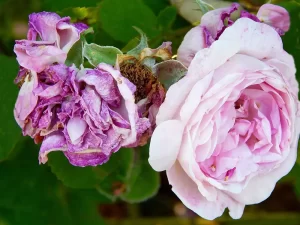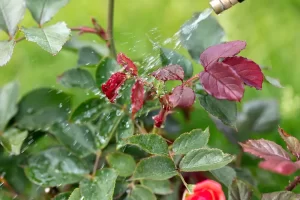Cut roses are synonymous with beauty, fragrance, and elegance. However, their allure can be swiftly marred by the onset of grey mould, known scientifically as Botrytis cinerea.
This pervasive fungal disease not only sullies the aesthetic of these blooms but also shortens their vase life, presenting a significant challenge for floriculturists and enthusiasts alike.
Understanding Botrytis: The Enemy of Cut Roses
 Grey mould thrives in cool, humid conditions, often attacking the delicate petals of roses, leading to unsightly browning and a rapid decline in health. The spores of the fungus can easily spread through the air, making containment a challenge, especially in commercial settings where large quantities of roses are stored and transported.
Grey mould thrives in cool, humid conditions, often attacking the delicate petals of roses, leading to unsightly browning and a rapid decline in health. The spores of the fungus can easily spread through the air, making containment a challenge, especially in commercial settings where large quantities of roses are stored and transported.
Chlorine Dioxide: Innovative Defence Against Rose Fungal Disease
Chlorine Dioxide (ClO2) is a versatile and powerful biocide that is gaining acclaim for its effectiveness in the horticultural sector. Unlike traditional fungicides, Chlorine Dioxide works by disrupting the protein synthesis of the mould, thereby halting its growth and preventing the spread of spores.
The Advantages of Using Chlorine Dioxide in Rose Care
1. Enhanced Efficacy: Chlorine Dioxide is highly effective against a broad spectrum of pathogens, including the stubborn Botrytis cinerea, ensuring comprehensive protection for your roses.
2. Safe for Delicate Blooms: When used correctly, ClO2 is gentle on the delicate tissues of rose petals, ensuring that the integrity and beauty of the flowers are preserved.
3. Environmentally Responsible: With a lower environmental footprint compared to many conventional fungicides, Chlorine Dioxide aligns with the growing demand for sustainable horticultural practices.
4. Extended Vase Life: By curbing the growth of grey mould, ClO2 treatments can significantly extend the vase life of cut roses, ensuring that they remain vibrant and fresh for longer periods.
Safe Application of Chlorine Dioxide in Horticulture
 Application of Chlorine Dioxide in the prevention and treatment of grey mould involves precise dosages and expert handling to ensure optimal results. It can be administered through aqueous solutions, fumigation, or as a preservative in the water of cut flowers.
Application of Chlorine Dioxide in the prevention and treatment of grey mould involves precise dosages and expert handling to ensure optimal results. It can be administered through aqueous solutions, fumigation, or as a preservative in the water of cut flowers.
Safety is paramount when using ClO2, and it is crucial to adhere to the guidelines for its use, ensuring that it poses no harm to users or the environment. At Scotmas, our products are designed for efficacy, user safety, and environmental sustainability, providing you with an unparalleled level of protection for your blooms. Contact us to learn more about our innovative approaches and how we can assist in nurturing the beauty of your cut roses.






